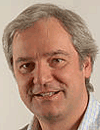Co-Located Conference AgendasAdvances in Biodetection & Biosensors | Advances in Microarray Technology | Lab-on-a-Chip European Congress | Single Cell Analysis Europe | 

Tuesday, 5 March 201308:00 | Registration | |
Advances in Protein and Antibody Arrays |
| | 09:00 |  | Keynote Presentation Protein Microarray Technologies - Analysis of Signaling Networks in Human Tumours
Markus Templin, Head, University of Tuebingen, Germany
Complex data sets generated from limiting sample material allow the identification of differences in activation of signaling networks directly on the protein level. Protein microarray analysis during anti- cancer drug development demonstrate the power of this technology. |
| 10:00 | Application of ChIP-on-chip Technology for Elucidating the Role of The Transcriptional Regulator AtrA in Streptomyces Coelicolor
Georgios Efthimiou, Postdoctoral Researcher, Metropolitan College, National and Kapodistrian University of Athens , Greece
A ChIP-on-chip method identified the binding loci of the transcription factor AtrA in the genome of Streptomyces coelicolor. Many genes were found to be regulated by AtrA, involved in processes such as primary metabolism, cell division and antibiotic production. | 10:30 | Coffee Break and Networking in the Exhibition Hall | 11:15 | Identification of a Protein Biomarker Signature Using Reverse Phase Protein Arrays (RPPA) for Risk Classification of Estrogen Receptor-Positive Breast Cancer
Ulrike Korf, Senior Scientist/Group Leader, German Cancer Research Center, Germany
Using reverse phase protein arrays (RPPA) a protein signature was identified that can distinguish between high and low risk luminal breast cancer. | 11:45 | Antibody-centric Profiling of Plasma Proteins in Disease Biobanks
Jochen Schwenk, Director- Plasma Profiling Facility, KTH Royal Institute of Technology, Sweden
The presentation will be about discovery projects for which antibodies from the Human Protein Atlas project and suspension bead array technology are used to protein profile serum and plasma. | 12:15 | Lunch and Networking in Exhibition Hall | 13:30 | Poster Viewing Session | 14:15 | Next Generation Arrays - Technology and Possibilities in Biomedicine
Carl Borrebaeck, Professor and Deputy Vice Chancellor, Lund University, Sweden
The specificities in antibody microarrays introduce a bias regarding which compartment to interrogate. We now describe the development of the next generation arrays, where discovery of previously unknown protein biomarkers can be achieved, using so called context independent motif-specific antibodies. | 14:45 | Polysaccharide Microarrays with a CMOS Based Signal Detection
Thomas Brandstetter, Group Leader, University of Freiburg, Germany
A simple procedure to create polysaccharide microarrays is presented, which can be used to analyze antibodies using an integrated, CMOS-based electric signal readout process including either chemiluminescence or fluorescence based detection. | 15:15 | Coffee Break and Networking in the Exhibition Hall | 16:00 | Fast-Tracking Molecular Diagnostics in Oncology via Antibody-Based Proteomics and Digital Pathology
William Gallaghr, Chief Scientific Officer/Professor, OncoMark Limited/University College Dublin, Ireland
This presentation will cover the utility of antibody-based profiling using tissue microarrays and associated digital pathology approaches to expedite the transition from biomarker discovery to validation in oncology. Case studies covering a range of cancer and biomarker types will be outlined. | |
Molecular Diagnostics |
| | 16:30 | Molecular Portraits of Systemic Lupus Erythematosus - unlocking Biomarker Discovery Using Antibody Micro- and Nanoarrays
Christer Wingren, Associate Professor And Lecturer, Lund University, Sweden
We have designed antibody micro- and nanoarrays for unlocking biomarker discovery. Using system lupus erythematosus as a showcase, we illustrate the potential of the technology platform for deciphering molecular portraits of the disease, paving the way for improved diagnosis and prognosis. | 17:00 | A Dual Label/Label Free, Highly Sensitive Protein Microarray Platform for Molecular Diagnostics
Marina Cretich, Researcher, National Research Council, Italy
In this presentation, a fluorescence microarray platform endowed with high sensitivity, coupled to label-free imaging for accurate quantification of immobilized probes is shown. Succesful examples of clinical relevance in the area of food allergy, inflammation, sepsis and Alzheimer's disease will be presented. | 17:45 | Round Table Discussions in Exhibition Hall |
Wednesday, 6 March 2013 |
Advances in DNA Arrays |
| | 09:00 |  | Keynote Presentation Reuse and Meta-analysis of Public Genome-wide Gene Expression Data
Alvis Brazma, Senior Team Leader of Functional Genomics, European Molecular Biology Laboratory, United Kingdom
Our understanding of gene expression has changed dramatically over the past decade, largely catalysed by technological developments. High-throughput experiments have generated large amounts of genome-wide gene expression data that are collected in public archives. Added-value databases process, analyse and annotate these data further to make them accessible to every biologist. We will discuss the utility of the gene expression data that are in the public domain and how researchers are making use of these data. We will also discuss trends in microarray growth and areas of applications. |
| 10:00 | Cell Lysate Arrays for High-throughput siRNA Screens
Ines Block, PostDoctoral Researcher, Institute for Molecular Medicine (Denmark), Denmark
Implementation of cell lysate arrays as supplementary readout of changes in protein quantities to increase the information gain from genome-wide siRNA screens. | 10:30 | Coffee Break and Networking in the Exhibition Hall | 11:15 | In Situ Synthesis of High Density RNA Microarrays
Mark Somoza, Professor, University of Vienna, Austria
High-density RNA microarrays, with hundreds of thousands of sequences, would be very useful for studying molecules that specifically interact with RNA—such as RNA-binding proteins, ribonucleases and drugs targeting RNA—and to make aptamer arrays for diagnostic applications. | |
Emerging Technologies |
| | 11:45 | Polymer Micorarrays - Controlling and Manipulating Stem Cells and the Identification of Bacterial "non-stick" Surfaces
Mark Bradley, Professor of Therapeutic Innovation, Precision Healthcare University Research Institute, Queen Mary University of London, United Kingdom
I will demonstrate a variety of approaches for the fabrication (including direct inkjet based polymer synthesis) and high-content screening of polymer microarrays and their application in a number of biological screens. This will include the first use of polymer microarrays to study bacterial adhesion/non-adhesion and the identification of polymers that allow stem cell growth and thermal harvesting. | 12:15 | Lunch and Networking in Exhibition Hall | 13:30 | Poster Viewing Session | 14:15 | To Dry or Not to Dry? Drop Drying and its Influence on Probe Immobilisation: a Key Step in Assay Development
Jens Sobek, Research Scientist, University of Zurich, Switzerland
Assay development often suffers from artifacts of unknown origin. We present results of a microarray model study showing the influence of drop drying on immobilization and its impact on assay performance. | 14:45 | Skinomics - The Use of Microarrays in Dermatology and Skin Biology
Miroslav Blumenberg, Associate Professor, NYU Langone Medical Center, United States of America
Due to accessibility skin and dermatology were among the earliest objects for microarray studies. Noninvasive skin sampling targeted melanomas; additionally, carcinomas, psoriasis, wound-healing, etc. have been analyzed. Recently, using microarrays identified genes specific for epidermal stem cells and those changing during keratinization. | 15:15 | Coffee Break and Networking in the Exhibition Hall | 15:45 | Towards Companion Diagnostics for Infectious Diseases
Till Bachmann, Reader, University of Edinburgh, United Kingdom
The alarming rise of antibiotic resistance increasingly causes massive extra costs and problems to the society. Rapid molecular diagnostics could help improving the use of antibiotics and secure the precious resource of this important class of drugs. | 16:15 | Single Molecule Arrays
Kalim Mir, Visiting Scholar, University of Oxford, United Kingdom
I will show how single molecules can be detected within microarray features and describe new long range sequencing can be conducted on
an array of stretched molecules. | 16:45 | Close of Conference |
|


 Add to Calendar ▼2013-03-05 00:00:002013-03-06 00:00:00Europe/LondonAdvances in Microarray TechnologyAdvances in Microarray Technology in Barcelona, SpainBarcelona, SpainSELECTBIOenquiries@selectbiosciences.com
Add to Calendar ▼2013-03-05 00:00:002013-03-06 00:00:00Europe/LondonAdvances in Microarray TechnologyAdvances in Microarray Technology in Barcelona, SpainBarcelona, SpainSELECTBIOenquiries@selectbiosciences.com